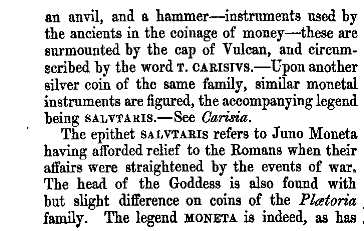Moneta
     | Please |help| us convert the |Dictionary of Roman Coins| from scans to text by typing the original text here. Please add updates or make corrections to the NumisWiki text version as appropriate. MONETA. This term was used by the Romans to designate their public mint in consequence of money having originally been struck at Rome in the temple of Juno Moneta. This was a surname given to the consort of Jupiter because she was said to have counselled the Romans to undertake none but just wars in which case she promised that they would never be in want of money. The name of Moneta was afterwards used alike to signify pieces of money, and the workshops or officinae in which they were fabricated. |
View whole page from the |Dictionary Of Roman Coins|
Moneta
     | Please |help| us convert the |Dictionary of Roman Coins| from scans to text by typing the original text here. Please add updates or make corrections to the NumisWiki text version as appropriate. MONETA. This term was used by the Romans to designate their public mint in consequence of money having originally been struck at Rome in the temple of Juno Moneta. This was a surname given to the consort of Jupiter because she was said to have counselled the Romans to undertake none but just wars in which case she promised that they would never be in want of money. The name of Moneta was afterwards used alike to signify pieces of money, and the workshops or officinae in which they were fabricated. There are some consular denarii of the Carisia family which on their obverse represent the head of a woman with the legend MONETA. On the reverse are a pair of pincers, an anvil and a hammer, all of which are the instruments used by the ancients in the coinage of money. These are surmounted by the cap of Vucan and circunscribed by the words T CARISUS. Upon another silver coin of the same family, similar monetal instruments are figured with the accompanying legend SALVTARIS. See Carisia. |
View whole page from the |Dictionary Of Roman Coins|